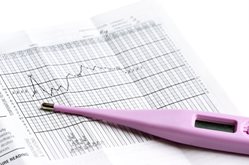Ovulation
 What is ovulation?
What is ovulation?
Ovulation is when one or more eggs are released from one of your ovaries. This is the most fertile time of your menstrual period. Each month 15 to 20 eggs mature inside the ovaries. The ripest egg is released and swept into the fallopian tube.
How does ovulation decide when I can get pregnant?
To become pregnant an egg and a sperm have to meet in the fallopian tube before the egg dies. An egg survives no more than 24 hours after ovulation. However sperm can survive for much longer inside the vagina. It has been found that sperm can survive for up to seven days.
This means that you do not have to time insemination to the exact time of ovulation to get pregnant. It is probably more realistic to think of a 'fertile window' of about four days when the live healthy sperm could meet a freshly ovulated egg.
How can I tell when I'm most fertile?
Ovulation usually takes place 10-16 days before the start of your next period. For a woman with a 28 day menstrual cycle, ovulation takes place sometime around day 13-15. The length of a normal menstrual cycle, however varies between 23 days and 35 days so ovulation could occur earlier or later in your cycle.
The simplest way to determine your most fertile time is to use an ovulation test. There are also other ways you can know when ovulation is imminent, these include changes in cervical mucus, lower abdominal pain, increased libido and increase in pheromones, which make your partner find you even more attractive!
Ovulation tests
Ovulation tests allow you to determine the correct ‘fertile window’ of your menstrual cycle. The end of the ovulation test strip is dipped into a morning sample of urine, this should be done daily at the same time each day within the middle of your cycle days 12-18, with day one being the first day of your cycle. Once your day of ovulation has been determined then this information will help predict the best times for inseminations to start the following month.
Insemination should commence 2-3 days before ovulation is due, and then be performed every 48hr after for 2-3 times within a month, for example if you ovulate on day 14 then inseminations would take place day 11, day 13 and day 15. or if only 2 inseminations are to be performed per month, then day 12 and 14 would be preferable.
Ovulation Cycle Chart
Usual cycle length
21 22 23 24 25 26 27 28 29 30 31 32 33 34 35 36 37 38 39 40
Days to begin testing
06 06 07 07 08 09 10 11 12 13 14 15 16 17 18 19 20 21 22 23
If your cycle is normally 28 days, the cycle chart above indicates you should begin testing on Day 11.
The calendar below shows you how to work out when day 11 is.
TEST PROCEDURE:
- Determine the day to begin testing.
- Collect urine sample in a clean and dry container.
- To begin testing, open the sealed pouch and remove the strip. Do not remove the strip until you are ready to begin testing.
- With the arrows pointing downwards towards the urine, place the test strip vertically (straight) into the urine sample, for at least 10 seconds. DO NOT allow the urine to go above the MAX (maximum) level line.
- Remove the strip from the urine and place on a clean, dry surface. For best results you should read the results at 10 minutes.
- Wait for coloured bands to appear. Depending on the concentration of LH in the urine specimen, positive results may be observed in as short as 40 seconds. However, to confirm negative results, the complete reaction time of 30 minutes is required